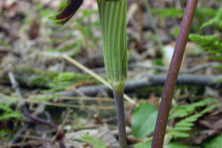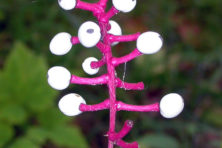Door to Nature: Plants in the Parsley Family
- Share
- Tweet
- Pin
- Share

The late summer roadsides are lined with tall white flowers which have a net-like appearance. That’s probably why they were given the common name, Queen Anne’s lace. These are considered weeds because they are not native, but introduced to our land by early settlers.
This plant’s family is Apiaceae, from the Latin apium, meaning “celery or parsley.” There are nearly two dozen species of this family in Wisconsin. Most are native, but a few of those which are invasive can be quite dangerous.
Queen Anne’s lace can grow to a height of five feet. The leaves are feathery and divided into many thin sections, like the cultivated carrot we grow in our gardens. The Latin name for Queen Anne’s lace is daucus carota, which is how it got the other common name: wild carrot.
Another introduced plant which begins growing along many roads in the northern part of our county in August is quite similar to Queen Anne’s lace: Burnet saxifrage, pimpinella saxifraga. It has similar white, lacy flowers as Queen Anne’s lace, but is lower-growing and develops a more open blossom that’s not as dense.
The Minnesota website for invasive plants tells of how few were reported in that state 10 years ago. Now they are becoming quite a nuisance along many open fields and roadsides. This non-native plant has high seed production and may form a mat so dense that other plants can’t grow through it.
I remember seeing it in the big fields along County Road ZZ two to three miles east of Sister Bay 30 years ago. I first thought it was Queen Anne’s lace, but when Roy examined it, he noticed its leaves were not thin and carrot-like, but resembled parsley.
He reported it to friends who worked in the botany department at the Milwaukee Public Museum and they never heard of it. Apparently, it was not reported from any other area of our state. Now it grows abundantly all the way down to County Road E between Baileys Harbor and Egg Harbor.
There are four other non-native species in this family that you should know about. They are the wild parsnip, Japanese hedge-parsley, caraway and poison hemlock. The last one, poison-hemlock, conium maculatum, is related to the plant that the Greeks used to execute criminals and the one that killed Socrates. The scientific name, conium, is Greek for hemlock.
This deadly plant has been recorded in three far northern counties and eight in southern Wisconsin. It is a biennial that can grow up to eight feet tall. It has green stems with purple spots and is widely branched with all parts being deadly poisonous. The closest county that has reported it is Sheboygan County.
I remember seeing quite a few wild parsnip plants blooming in Michigan’s Upper Peninsula 10 years ago when Roy and I vacationed there. This plant appears like Queen Anne’s lace but has large yellow flowers up to eight inches across. They grow to five feet tall and are frequently seen along roadsides. We have found them in southern Door County.
This plant causes photo-dermatitis, so avoid all contact with your skin. If the plant rubs against your legs or arms and then you are exposed to sunlight you will develop a painful rash, perhaps more severe than poison ivy. It has been reported in much of Wisconsin except about 10 counties in the far northwest.
There are a few native species in this family that you may know. Have you hiked in autumn and found sharply pointed inch-long black seeds stuck in your socks? They probably came off the common woodland plant we call “sweet cicely.” Three varieties grow in the state and the most common is the hairy sweet cicely.
One plant that has been common at Whitefish Dunes State Park and along some eastern county roadsides is American cow parsnip. It is a perennial that can grow up to 10 feet tall. Some texts say that you can get dermatitis from contact with this plant, but not as severe as with wild parsnip.
Some texts say the plant is edible but the stalks must be peeled before cooking. If not, the plant can cause blistering of the mouth. Perhaps that is why cow parsnip is also called Satan celery!
A close relative is giant hogweed that was found in Iron County and in several counties in southeast Wisconsin. It is more common out west, but can spread in our state. The plant is very toxic and must be avoided. It grows 10-15 feet tall, so it is not difficult to see.
Learn about these interesting plants in the parsley family and know which ones you should not touch.



